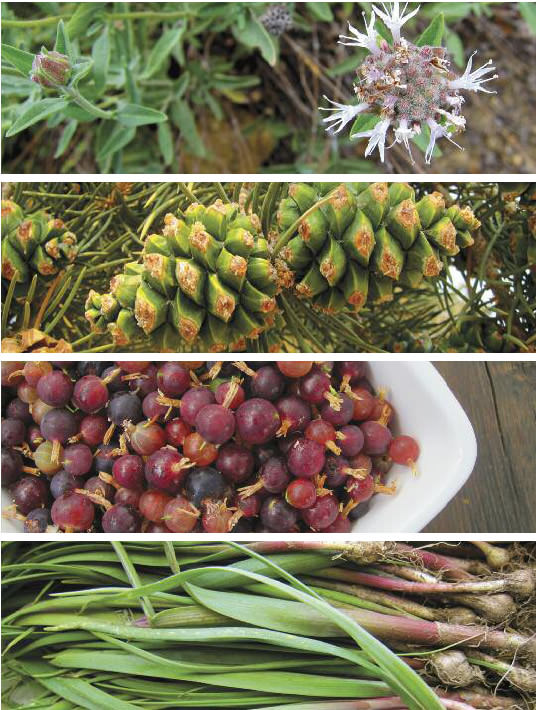feature
NATURE’S GARDEN
What grows in our forests and along our rivers, lakes, and streams that’s ripe for the plucking?
Read on. Then get ready to forage!
WRITTEN BY ERIN MEYERING
PHOTOS BY HANK SHAW AND HOLLY A. HEYSER
We’ve all heard a story from someone who has collected berries during an evening walk. Perhaps you’ve turned green with envy, imagining the idyllic scene and craving the fresh berry pie that can be made with that bounty. Or, perhaps, you yourself have told such a tale.
Foraging for your own wild edibles can be truly invigorating — that experience of stumbling upon a desirable plant, holding it close to smell and inspect it, considering the deliciousness you may have discovered.
The act, however, can do more than delight your senses. It also can expand your knowledge about what grows in the area and expose you to varieties of food that you may not have encountered before.
Found treasures
 What can you find this time of year? In the fall, there may be lingering varieties of mushrooms, especially white porcinis and, in the middle of the Sierra, plenty of acorns and stinging nettle.
What can you find this time of year? In the fall, there may be lingering varieties of mushrooms, especially white porcinis and, in the middle of the Sierra, plenty of acorns and stinging nettle.
Pine nuts are plentiful and easily collected, but, depending on the weather conditions, can have inconsistent harvests.
Warmer months bring a larger variety of wild edibles to our local landscape. From April to September, you can spot currants, gooseberries, a variety of mushrooms, and greens.
“A lot of wild, edible plants no longer occur in the abundance they used to,” says Evert Broderick, a professor at Truckee Meadows Community College for the herbal studies program. His wife, Kim Powers, also teaches courses and workshops on wild edibles and medicinal plants.
Although they may be scarcer, many can be found in and around Lake Tahoe, Fallon, and the Sierra Nevada.
Head this direction
Going out to forage, especially if you are new to it, can be overwhelming. Venturing into the forest and happening upon a vast mushroom patch certainly is ideal, but probably not what will happen.
“The No. 1 most basic advice is to start in your own backyard — literally,” says Hank Shaw, a hunter, fisherman, big-time forager, and author of two books (Duck Duck Goose: The Ultimate Guide to Cooking Waterfowl, Both Farmed and Wild and Hunt, Gather, Cook: Finding the Forgotten Feast).
Another way to get into foraging is to start learning about plants, Broderick says.
Guidebooks, combined with credible Internet sources, can lead you in the right direction. Be wary of lookalike plants, though. Both Shaw and Broderick say many plants can easily be mistaken for popular edible ones, if you aren’t careful.
Once you can successfully identify plant varieties and are ready to expand your picking field, try new locales and safely explore.
“Tahoe has a diversity of environments to play in,” Shaw says.
Because of Tahoe’s climate and topography, it offers areas with what Shaw says is the perfect shade and moisture environment for mushrooms.
Safety first
While the hunt for wild edibles is fun and invigorating, it does require some responsibilities.
Cross-reference everything. Even two plants of the same variety do not look identical. If you find a great wild edible, take a picture for your reference later, when you can look it up and be sure it’s safe to eat.
“Foraging safely is not rocket science, but it does require some research,” Shaw says.
Erin Meyering is a vegetable, fruit, and natural foods nut. She loves the idea of going out to look for one’s own edibles. After writing this story, she believes foraging allows one to become more knowledgeable about the food they’re eating.
Resources
Hank Shaw has a wealth of knowledge about hunting for wild edibles and has two info-packed books, Duck, Duck, Goose: The Ultimate Guide to Cooking Waterfowl, Both Farmed and Wild and Hunt, Gather, Cook: Finding the Forgotten Feast. His website, http://www.Honest-food.net also contains thoughtful recipes that incorporate wild edibles.
The Living Wild Project, created by longtime natural living and wellness practitioner, Alicia Funk, provides recipes and tips for wild edibles, categorized by season. Funk introduced the Wellness Spa into Whole Foods Markets and is the editor of six books, including The Botanical Safety Handbook and The ABC Clinical Guide to Herbs. For details, visit http://www.Livingwild.org
San Francisco State University’s Sierra Nevada Field Campus offers several classes and workshops on wild edibles, their identification, and what exists in the Reno-Tahoe area. For details, visit http://www.sfsu.edu/~sierra
Truckee Meadows Community College also offers a few courses on herbal studies and plant identification, with an emphasis on medicinal plants, some of which are forageable. For details, visit http://www.Tmcc.edu/wdce/programs/herbal-studies-
The Nevada Native Plant Society is a local nonprofit organization striving to educate and conduct research on native Nevada plants. The group is concerned with the preservation of these plants sharing their value so that they can be fully appreciated. For details, visit http://www.Nvnps.org
The Laws Field Guide to the Sierra Nevada by John Muir Laws offers a comprehensive, fully illustrated guide to the rich variety of life in the Sierra, with more than 1,700 species featured. For details, visit http://www.Johnmuirlaws.com
Wild Food Adventures in Portland, Ore., is an institution specializing in the study of wild edible plants and other forageables. The organization’s founder, John Kallas, is the author of Edible Wild Plant; Wild Foods From Dirt to Plate.


